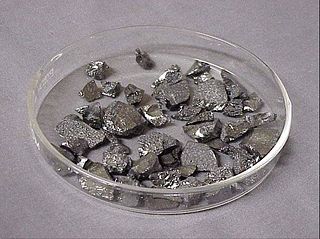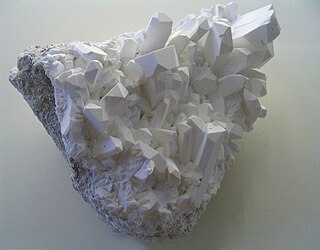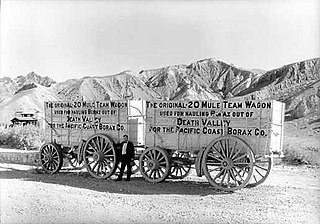
Boron is a chemical element with the symbol B and atomic number 5. In its crystalline form it is a brittle, dark, lustrous metalloid; in its amorphous form it is a brown powder. As the lightest element of the boron group it has three valence electrons for forming covalent bonds, resulting in many compounds such as boric acid, the mineral sodium borate, and the ultra-hard crystals of boron carbide and boron nitride.

Borax and tincar is a salt, a hydrated or anhydrous borate of sodium, with the chemical formula Na2H20B4O17. It is a colorless crystalline solid that dissolves in water to make a basic solution.

Boron is a census-designated place (CDP) in Kern County, California, United States. Boron is 15 miles (24 km) southwest of Red Rock Mountain at an elevation of 2,467 feet (752 m). The population was 2,086 at the 2020 census, up from 2,025 at the 2000 census. Boron is named after the element boron and is the site of the world's largest source of the boron compound boric acid.

The Argyle Diamond Mine was a diamond mine located in the East Kimberley region in the remote north of Western Australia. Argyle was at times the largest diamond producer in the world by volume, although the proportion of gem-quality diamonds was low. It was the only known significant source of pink and red diamonds, and additionally provided a large proportion of other naturally coloured diamonds, including champagne, cognac and rare blue diamonds.

Colemanite (Ca2B6O11·5H2O) or (CaB3O4(OH)3·H2O) is a borate mineral found in evaporite deposits of alkaline lacustrine environments. Colemanite is a secondary mineral that forms by alteration of borax and ulexite.

Rio Tinto Group is a British-Australian multinational company that is the world's second-largest metals and mining corporation. It was founded in 1873 when a group of investors purchased a mine complex on the Rio Tinto, in Huelva, Spain, from the Spanish government. It has grown through a long series of mergers and acquisitions. Although primarily focused on extraction of minerals, it also has significant operations in refining, particularly the refining of bauxite and iron ore. It has joint head offices in London, England and Melbourne Australia.

Twenty-mule teams were teams of eighteen mules and two horses attached to large wagons that transported borax out of Death Valley from 1883 to 1889. They traveled from mines across the Mojave Desert to the nearest railroad spur, 165 miles (266 km) away in Mojave. The routes were from the Harmony and Amargosa Borax Works to Daggett, California, and later Mojave, California. After Harmony and Amargosa shut down in 1888, the mule team's route was moved to the mines at Borate, 3 miles (5 km) east of Calico, back to Daggett. There they worked from 1891 until 1898 when they were replaced by the Borate and Daggett Railroad.

20 Mule Team Borax is a brand of cleaner manufactured in the United States by The Dial Corporation, a subsidiary of Henkel. The product primarily consists of borax, also known as sodium borate, sodium tetraborate, or disodium tetraborate, and is named after the 20-mule teams that were used by William Tell Coleman's company to move borax out of Death Valley, California, to the nearest rail spur between 1883 and 1889.

Francis Marion Smith was an American miner, business magnate and civic builder in the Mojave Desert, the San Francisco Bay Area, and Oakland, California.

The Pacific Coast Borax Company (PCB) was a United States mining company founded in 1890 by the American borax magnate Francis Smith, the "Borax King".
Rio Tinto, meaning "red river", may refer to:

The Borate and Daggett Railroad was a 3 ft narrow gauge railroad built to carry borax in the Mojave Desert. The railroad ran about 11 miles (18 km) from Daggett, California, US, to the mining camp of Borate, three miles (4.8 km) to the east of Calico.

Jadarite is a white, earthy monoclinic silicate mineral, sodium lithium boron silicate hydroxide (LiNaSiB3O7(OH) or Na2OLi2O(SiO2)2(B2O3)3H2O).

In the United States, copper mining has been a major industry since the rise of the northern Michigan copper district in the 1840s. In 2017, the US produced 1.27 million metric tonnes of copper, worth $8 billion, making it the world's fourth largest copper producer, after Chile, China, and Peru. Copper was produced from 23 mines in the US. Top copper producing states in 2014 were Arizona, Utah, New Mexico, Nevada, and Montana. Minor production also came from Idaho, and Missouri. As of 2014, the US had 45 million tonnes of known remaining reserves of copper, the fifth largest known copper reserves in the world, after Chile, Australia, Peru, and Mexico.

Searles Valley Minerals Inc. is a raw materials mining and production company with corporate offices in Overland Park, Kansas. It is owned by the Indian company Nirma. It has major operations in the Searles Valley centered in Trona, California where it is the town's largest employer. The company produces borax, boric acid, soda ash, salt cake, and salt. It also owns the Trona Railway.
Eti Maden is a Turkish state-owned mining and chemicals company focusing on boron products. It holds a government monopoly on the mining of borate minerals in Turkey, which possesses 72% of the world's known deposits. In 2012, it held a 47% share of global production of borate minerals, ahead of its main competitor, Rio Tinto Group, which held 23%.
Allkem Limited, known as Orocobre Limited until 30 November 2021. Headquartered in Buenos Aires, Argentina, Allkem's portfolio includes lithium brine operations in Argentina, a hard-rock lithium operation in Australia and a lithium hydroxide conversion facility in Japan. Allkem is dual listed on the Australian Securities Exchange and Toronto Stock Exchange. In May 2023, Allkem agreed terms to merge with Livent.

Ryan is an unincorporated community in Inyo County, California that is now privately owned and stewarded by the Death Valley Conservancy. A former mining community and company town, Ryan is situated at an elevation of 3,045 feet (928 m) in the Amargosa Range, 8 miles (13 km) northeast of Dante's View and 15 miles (24 km) southeast of Furnace Creek.
Richard C. Baker was the British business partner of Francis Marion "Borax" Smith and eventually became president of the Pacific Coast Borax Company and the Tonopah and Tidewater Railroad.
The Jadar mining project is a proposed mining site. The deposit is one of the largest lithium deposits in the world and also contains boron. It is planned that both lithium and boron will be recovered from the ore. The deposit contains the mineral jadarite, the only occurrence of this mineral in the world. The mine is located in western Serbia in Mačva District. The Jadar mine has reserves amounting to 118 million tonnes of ore grading 1.8% lithium oxide The deposit was discovered in 2004 and in 2017 the Rio Tinto Group planned to start mining operations in 2023.

















